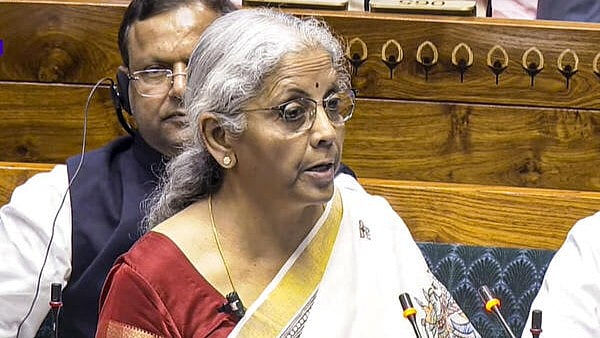
Union Finance Minister Nirmala Sitharaman presents the Union Budget 2025-26 in the Lok Sabha, in New Delhi on Saturday.
Credit: PTI Photo
New Delhi: In a major relief to the middle class, the Narendra Modi government on Saturday announced that there would not be any tax liability on income upto Rs 12 lakh for salaried persons under the new tax regime and raised the basic exemption from Rs 2.5 lakh to Rs 4 lakh.
“A tax payer in the new regime with an income of Rs 12 lakh will get a benefit of Rs 80,000 in tax (which is 100 per cent of tax payable as per existing rates),” Finance Minister Nirmala Sitharaman announced in the Union Budget 2025-26.
A person having income of Rs 18 lakh will get a benefit of Rs 70,000 in tax (30 per cent of tax payable as per existing rates). A person with an income of Rs 25 lakh gets a benefit of Rs 1,10,000 (25 per cent of his tax payable as per existing rates), she said.
As per existing rates, tax liability on income upto Rs 7 lakh is zero. With standard deductions of upto Rs 75,000, this comes to Rs 7.75 lakh. The standard deductions will continue. So for the salaried people with standard deductions the tax liability on upto Rs 12.75 lakh would become zero.
“The Finance Minister has focused on boosting consumption by putting more money in the hands of people,” said Sonu Iyer, Partner and National Leader, People Advisory Services, EY India.
The basic exemption has been increased from Rs 2.5 lakh to Rs 4 lakh. This means for the financial year 2025-26 the tax rate on income upto Rs 4 lakh will be zero. For the current financial year the basic exemption for those aged below 60 years was Rs 2.5 lakh.
“Slabs and rates are being changed across the board to benefit all taxpayers. The new structure will substantially reduce the taxes of the middle class and leave more money in their hands, boosting household consumption, savings and investment,” the finance minister said.
Tax rate on income upto Rs 4 lakh will be zero. Income upto Rs 4-8 lakh will be taxed at the rate of 5 per cent; Rs 8-12 lakh at 10 per cent; Rs 12-16 lakh at 15 per cent; Rs 16-20 lakh at 20 per cent; Rs 20-24 lakh at 25 per cent and above Rs 24 lakh at 30 per cent.
To taxpayers with upto Rs 12 lakh of normal income (other than special rate income such as capital gains) tax rebate is being provided in addition to the benefit due to slab rate reduction in such a manner that there is no tax payable by them.
Sitharaman said that revenue forgone due to changes in direct tax rates would be Rs 1 lakh crore.
The finance minister announced that the government would introduce a new income tax bill that would make the tax laws simpler. “The new bill will be clear and direct in text with close to half of the present law, in terms of both chapters and words. It will be simple to understand for taxpayers and tax administration, leading to tax certainty and reduced litigation,” she said.
“The twin announcements of removal of seven tariffs resulting into reduced eight slabs of duty and levy of only one cess or surcharge, thereby exempting 82 tariff line items from social welfare surcharge, would both lead to simplification of import duty computation, thereby easing compliances” said Harpreet Singh, Partner, Indirect Tax, Deloitte.
Proposals relating to customs duty include rationalisation of tariff structure by reducing the tariff rates from 15 to 8 slabs, exemption on life-saving drugs for cancer treatment, capital goods used for manufacture of lithium-ion batteries for EVs and mobile phones, specified parts for LCD/ LED TVs, reduction in duties for telecom goods, etc.
“These measures would help make India a global hub for manufacturing. Service exports would further enhance through setting up of GCCs in tier-2 cities. Overall, the push is towards making India a key player in the global economy while providing a simplified tax framework and ease in doing business,” said Saloni Roy, Partner, Deloitte India.
“The Union Budget has struck the right chord balancing fiscal prudence with supporting the slowdown in private demand. The re-emphasis on fiscal consolidation roadmap over the next few years too remains comforting for the markets," said Upasna Bhardwaj, Chief Economist, Kotak Mahindra Bank.
Union Budget 2025 | Nirmala Sitharaman, who continues to be Finance Minister, presented her record 8th Union Budget this time. While inflation has burnt a hole in the pockets of 'aam janata', the Modi govt gave tax relief for those making up to Rs 12 lakh per year in salaried income. Track the latest coverage, live news, in-depth opinions, and analysis only on Deccan Herald. Also follow us on WhatsApp, LinkedIn, X, Facebook, YouTube, and Instagram.